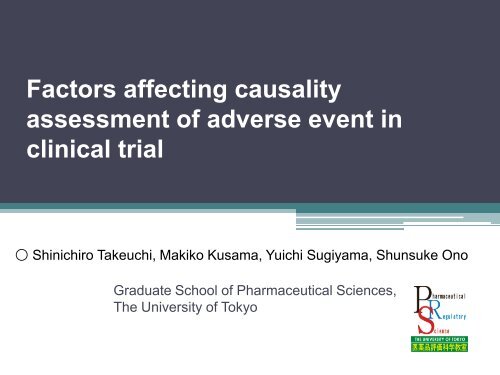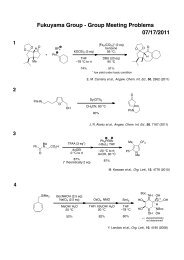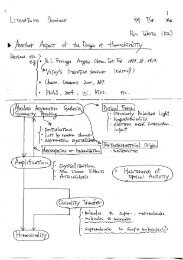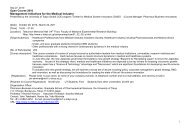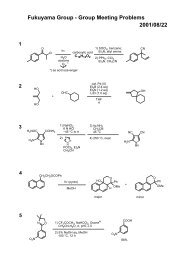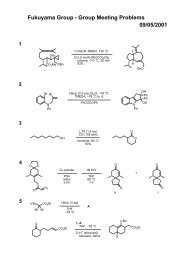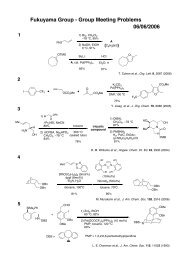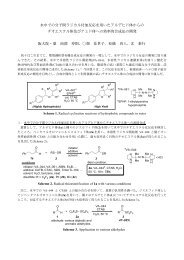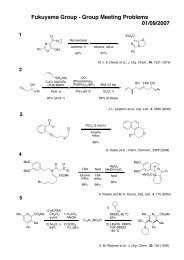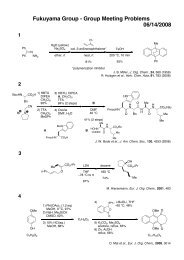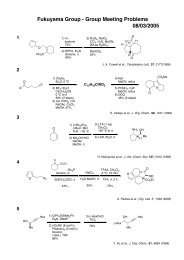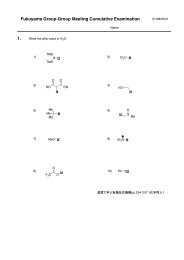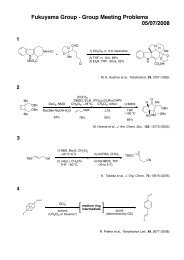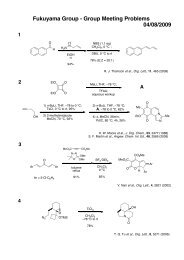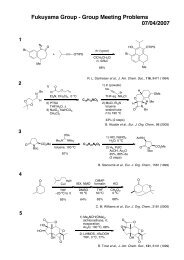Factors affecting causality assessment of adverse event in clinical trial
Factors affecting causality assessment of adverse event in clinical trial
Factors affecting causality assessment of adverse event in clinical trial
You also want an ePaper? Increase the reach of your titles
YUMPU automatically turns print PDFs into web optimized ePapers that Google loves.
<strong>Factors</strong> <strong>affect<strong>in</strong>g</strong> <strong>causality</strong><br />
<strong>assessment</strong> <strong>of</strong> <strong>adverse</strong> <strong>event</strong> <strong>in</strong><br />
cl<strong>in</strong>ical <strong>trial</strong><br />
○ Sh<strong>in</strong>ichiro Takeuchi, Makiko Kusama, Yuichi Sugiyama, Shunsuke Ono<br />
Graduate School <strong>of</strong> Pharmaceutical Sciences,<br />
The University <strong>of</strong> Tokyo
Background & Objective<br />
Background<br />
Adverse Events (AEs) and Adverse Drug Reactions<br />
(ADRs) <strong>in</strong> cl<strong>in</strong>ical <strong>trial</strong>s give safety <strong>in</strong>formation <strong>of</strong> the drug<br />
Investigators assess <strong>causality</strong> <strong>of</strong> AEs when it happens. If<br />
relationship between AE and drug cannot be denied, it is<br />
recorded as ADR<br />
Objective<br />
Investigate the factors relat<strong>in</strong>g to <strong>causality</strong> <strong>assessment</strong> <strong>in</strong><br />
cl<strong>in</strong>ical <strong>trial</strong>s<br />
2
Safety Assessment <strong>in</strong> Drug Development<br />
<br />
• Bl<strong>in</strong>d / Open-label<br />
• Study period<br />
• etc<br />
3<br />
Dr<br />
A<br />
• Study drug<br />
• Target disease<br />
• Concomitant disease<br />
Adverse Drug Reactions<br />
Dr<br />
B<br />
Adverse Events<br />
Product A<br />
Dr<br />
C<br />
・・・<br />
• Concomitant drug<br />
• Occasional case<br />
• Other factors<br />
Study B Study C<br />
Causality<br />
<strong>assessment</strong><br />
• Observation<br />
• Knowledge<br />
• Information
Method & Observation<br />
Method<br />
Calculated “Causality rate”, def<strong>in</strong>ed as follows<br />
(Unit: MeDRA System Organ Class [SOC])<br />
Investigate the factors which affect <strong>causality</strong> rate<br />
Observation<br />
Number <strong>of</strong> ADRs and AEs (SOC) <strong>in</strong> cl<strong>in</strong>ical study <strong>of</strong><br />
NMEs approved by PMDA <strong>in</strong> 2009 and 2010<br />
4<br />
Number <strong>of</strong> ADR<br />
Number <strong>of</strong> AE<br />
=Causality rate
Analytical Method<br />
Multi level analysis:<br />
Cross random effect:SOC・・・a<br />
5<br />
ATC 1 ATC 2 ATC 3<br />
Product 1 Product 2<br />
Study 1 Study 2<br />
・・・ k = Study<br />
・・・ j = Product<br />
・・・ i = ATC code<br />
Y ijka = β 0 + β 11 X 11 + ・・・ + β ijX ij + ζ ia + ζ ija + ζ ijka + ε ijka<br />
Dependent<br />
variable<br />
Explanatory<br />
variable<br />
Cross random<br />
effect<br />
Error
Exploratory variables<br />
Product<br />
Orphan*, Biologics*, Route <strong>of</strong> adm<strong>in</strong>istration<br />
Study design<br />
Phase, Patient*, Open-label*, Active comparator*, Placebo*,<br />
Number <strong>of</strong> patient, Study period, Number <strong>of</strong> arm<br />
Study <strong>in</strong>formation<br />
AE ratio <strong>in</strong> cl<strong>in</strong>ical <strong>trial</strong>s, AE observed <strong>in</strong> previous cl<strong>in</strong>ical <strong>trial</strong>*,<br />
ADR observed <strong>in</strong> previous cl<strong>in</strong>ical <strong>trial</strong>*, ADR <strong>causality</strong> ratio <strong>in</strong><br />
previous cl<strong>in</strong>ical <strong>trial</strong><br />
Others<br />
6<br />
*Dummy variable(No=0, Yes=1)<br />
Company* (Foreign company = 1, Domestic company = 0), Drug<br />
lag
Causality Rate<br />
Mean Std. Dev.<br />
System Organ Class<br />
Blood and lymphatic system disorders 0.49 0.43<br />
Cardiac disorders 0.46 0.40<br />
Ear and labyr<strong>in</strong>th disorders 0.48 0.46<br />
Endocr<strong>in</strong>e disorders 0.44 0.47<br />
Gastro<strong>in</strong>test<strong>in</strong>al disorders 0.42 0.35<br />
General disorders 0.48 0.41<br />
Hepatobiliary disorders 0.42 0.40<br />
Immune system disorders 0.14 0.28<br />
Infections and <strong>in</strong>festations 0.09 0.22<br />
Injury, poison<strong>in</strong>g and procedural complications 0.03 0.09<br />
Investigations 0.63 0.34<br />
Musculoskeletal and connective tissue disorders 0.16 0.26<br />
Neoplasms benign, malignant and unspecified 0.30 0.40<br />
Psychiatric disorders 0.40 0.41<br />
Reproductive system and breast disorders 0.28 0.38<br />
Surgical and medical procedures 0.04 0.13<br />
Vascular disorders 0.44 0.43<br />
Eye disorders 0.29 0.38<br />
Metabolism and nutrition disorders 0.49 0.41<br />
Nervous system disorders 0.38 0.39<br />
Renal and ur<strong>in</strong>ary disorders 0.49 0.44<br />
Respiratory, thoracic and mediast<strong>in</strong>al disorders 0.18 0.27<br />
Sk<strong>in</strong> and subcutaneous tissue disorders 0.35 0.36<br />
All ADR 0.35 0.39<br />
7<br />
Mean Std. Dev.<br />
ATC<br />
Alimentary Metabolism 0.22 0.31<br />
Anti <strong>in</strong>fective 0.44 0.45<br />
Anti neoplastic 0.62 0.41<br />
Cardiovascular 0.38 0.40<br />
Genitour<strong>in</strong>ary 0.12 0.23<br />
Nervous 0.58 0.38<br />
Respiratory 0.10 0.22<br />
Sensory<br />
Route <strong>of</strong> adm<strong>in</strong>istration<br />
0.12 0.28<br />
Inhalation 0.33 0.42<br />
Eye drop 0.12 0.28<br />
Intravenous <strong>in</strong>jection 0.47 0.42<br />
Nose spray 0.14 0.25<br />
Oral 0.37 0.39<br />
Subcutaneous <strong>in</strong>jection<br />
Phase<br />
0.21 0.33<br />
Phase I 0.52 0.47<br />
Phase II 0.37 0.40<br />
Phase III 0.30 0.35<br />
*All m<strong>in</strong> is “0” and all max is 1”
Results (1/2)<br />
Base Model : Variables about product, study design, and previous <strong>in</strong>formation<br />
8<br />
N = 1425<br />
Variables Coef. P>z<br />
Orphan 0.207 0.063 *<br />
Number <strong>of</strong> arms 0.024 0.040 **<br />
AE ratio <strong>in</strong> the study 0.228 0.000 ***<br />
Same ADR observed <strong>in</strong> previous study 0.202 0.000 ***<br />
Same AE observed <strong>in</strong> previous study -0.042 0.066 *<br />
Study period -0.005 0.087 *<br />
Note: Variables with no statistical significance are not shown
Result (2/2)<br />
Model2: Drug lag and Causality rate <strong>in</strong> previous study are <strong>in</strong>cluded<br />
9<br />
N = 592<br />
Variables Coef. P>z<br />
Patient study 0.267 0.070 *<br />
Active comparator 0.125 0.011 **<br />
AE ratio <strong>in</strong> the study 0.290 0.000 ***<br />
Causality rate <strong>in</strong> previous study 0.218 0.000 ***<br />
Intravenous <strong>in</strong>jection 0.318 0.089 *<br />
Note: Variables with no statistical significance are not shown
Discussion (1/3)<br />
Variable associated with <strong>in</strong>crease <strong>in</strong> <strong>causality</strong> rate<br />
Variables Possible causes<br />
Orphan Causality cannot be def<strong>in</strong>itely denied because<br />
accumulated data is limited<br />
Active comparator Investigators consider the possibility <strong>of</strong> be<strong>in</strong>g<br />
allocated to active comparator arm<br />
Number <strong>of</strong> arms Many number <strong>of</strong> arms make it difficult to<br />
consider which drug is treated. And <strong>causality</strong><br />
can not be denied<br />
Patient study Patient study is conducted later stage therefore<br />
study drug <strong>in</strong>formation is collected more.<br />
10
Discussion (2/3)<br />
Variable associated with <strong>in</strong>crease <strong>in</strong> <strong>causality</strong> rate<br />
Variables Possible causes<br />
Intravenous <strong>in</strong>jection AE relat<strong>in</strong>g to <strong>in</strong>jection site <strong>in</strong>crease the<br />
<strong>causality</strong> rate<br />
AE ratio <strong>in</strong> the study Investigators consider the relationship<br />
between AE and drug when they see the AE<br />
is frequently observed<br />
Same ADR observed <strong>in</strong><br />
previous study<br />
Causality rate <strong>in</strong> previous<br />
study<br />
11<br />
Investigators consider <strong>causality</strong> as positive<br />
when same ADR was observed <strong>in</strong> previous<br />
study<br />
If relationship between AE and drug was<br />
affirmed <strong>in</strong> previous study, <strong>causality</strong> is<br />
considered as positive <strong>in</strong> current study, too
Discussion (3/3)<br />
Variable associated with decrease <strong>in</strong> <strong>causality</strong> rate<br />
Variables Possible cause<br />
Study period The longer observation period is, the more<br />
<strong>causality</strong> can be denied; for example AE<br />
recovers even though subject cont<strong>in</strong>ues to be<br />
treated with <strong>in</strong>vestigational drug<br />
Same AE observed <strong>in</strong><br />
previous study<br />
12<br />
Investigator consider ADRs as important (same<br />
ADR <strong>in</strong> previous study does <strong>affect<strong>in</strong>g</strong> to<br />
<strong>in</strong>crease strongly)
Conclusion<br />
Some factors, e.g. study design and drug <strong>in</strong>formation, affect<br />
<strong>causality</strong> rate with statistical significance<br />
These factors relate to <strong>causality</strong> <strong>assessment</strong> <strong>in</strong> cl<strong>in</strong>ical <strong>trial</strong>s.<br />
Give <strong>in</strong>formation to Investigators’ <strong>assessment</strong><br />
Or <strong>in</strong>directly relate to the way <strong>of</strong> <strong>assessment</strong><br />
Careful <strong>in</strong>terpretation is necessary because <strong>causality</strong> is<br />
assessed by Investigators based on their knowledge and<br />
observation and these factors do not affect <strong>causality</strong><br />
<strong>assessment</strong> directly<br />
13
The 32 nd Annual Meet<strong>in</strong>g <strong>of</strong> the Japanese Society<br />
<strong>of</strong> Cl<strong>in</strong>ical Pharmacology and Therapeutics<br />
Title :<strong>Factors</strong> <strong>affect<strong>in</strong>g</strong> <strong>causality</strong> <strong>assessment</strong> <strong>of</strong> <strong>adverse</strong><br />
<strong>event</strong> <strong>in</strong> cl<strong>in</strong>ical <strong>trial</strong><br />
Affiliation :Laboratory <strong>of</strong> Pharmaceutical Regulatory Science,<br />
Graduate School <strong>of</strong> Pharmaceutical Sciences,<br />
The University <strong>of</strong> Tokyo<br />
Presenter :Sh<strong>in</strong>ichiro Takeuchi<br />
Conflict <strong>of</strong> Interest;<br />
We declare that we have no proprietary, f<strong>in</strong>ancial,<br />
pr<strong>of</strong>essional and any k<strong>in</strong>d <strong>of</strong> other personal <strong>in</strong>terest <strong>of</strong><br />
any nature from company or any organization accord<strong>in</strong>g<br />
to COI policy <strong>of</strong> JSCP<br />
14


